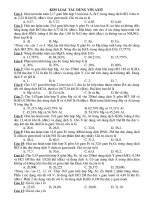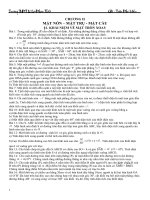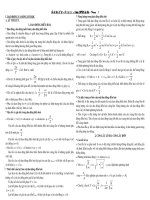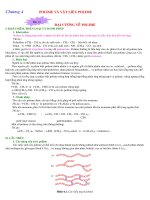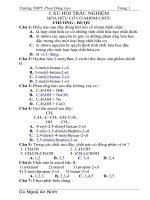bài tập khối 12
Bạn đang xem bản rút gọn của tài liệu. Xem và tải ngay bản đầy đủ của tài liệu tại đây (194.8 KB, 3 trang )
<span class='text_page_counter'>(1)</span><div class='page_container' data-page=1>
1
<b>BÀI TẬP KHỐI 12 </b>
TUẦN TỪ 6-4 đến 11-4 năm 2020
- HỌC TỪ NGỮ UNIT 11
- LÀM BÀI TẬP DƯỚI ĐÂY
<b>Choose the best answer </b>
1. He hurried _________ he wouldn’t be late for class.
A. since B. as if C. unless D. so that
2. There should be no discrimination _______ grounds of sex race or religion
A. on B. at C. of D. in
3. He has refused, but he _________ change his mind if you asked him again
A. might B. may C. can D. must
4. Two parallel white lines in the millde road meant that you _________ not
overtake.
A. must B. might C. may D. need
5. There’s _______ university in my neighborhood.
A. an B. a C. the D. Φ
<b>Choose the underlined words that need correcting. </b>
6. The bus will be leaving on five minutes so you’d better hurry up.
A B C D
7. Many teachers have devoted their lives to teaching, therefore teaching is not a
well-paid job.
A B C D
8. My parents often take careful of me when I am ill.
A B C D
9. She passed the board exam, who made her parents proud.
A B C D
10. Lack of properly physical exercise cause tiredness and poor health.
A B C D
<b>Read the passage and choose the best answers. </b>
World Wildlife Fund (WWF) safeguards hundreds of species around the world, but
we focus species attention on our flagship species: giant pandas, tigers, endangered
whales and dolphins, rhinos, elephant, marine turtles and great apes. These species not
only need species measures and extra protection in order to survive, they also serve as
“umbrella” species: helping them helps numerous other species that live in the same
habitats.
</div>
<span class='text_page_counter'>(2)</span><div class='page_container' data-page=2>
2
wildlife trade experts at “traffic” work to ensure that trade wildlife products, doesn’t
harm a species, while also fighting against illegal and unsustainable trade.
WWF is known for acting sound science. Science leads and guides us strategies and
approaches, from the way to restore tigers in viable, breed population to decide which
areas need protection the most.
11. What does WWF stand for?
A. World Wildlife Food. B. World Wildlife Formation.
C. World Wildlife Fund. D. World Website Fund.
12. How many species do we pay much attention to?
A. 5 B. 8 C. 7 D. 9
13. What is the meaning of the world <i>habitats</i> in pharagraph 1?
A. The place where animals or plants are normally found.
B. The place where animals or plants can drink and sleep.
C. The place where animals or plants can eat find their enemy.
D. The place where animals can find and keep their body warm.
14. What can science help us in safeguarding endangered species?
A. Find the way to kill all species easily. B. Lead and guide strategies and
approaches.
C. Discover another habitat of animal. D. Search for a food source for animals.
15. Which of the following is not stated in the passage?
A. WWF safeguards hundreds of species around the world.
B. WWF is known for acting on sound science.
C. these above species need extra protection so as not to be extinct.
D. All species are so fierce that scientists can’t take care of them.
<b>Read and choose the appropriate option: </b>
<b>WHY DO ANIMALS GO EXTINCT? </b>
Different kinds of animals have appeared and disappeared throughout Earth’s
history. Some animals go extinct because the climate (16) _______ they live changes.
The climate may become wetter or drier. It may become warmer or cooler. If the animals
cannot change, or adapt, to the new climate, they die.
Some animals go extinct because thay cannot (17) _______ with other animals for
food. Some animals go extinct because they are killed by enemies. New kinds of animals
are always evolving. Evolving means that the animals are changing (18) _______ from
generation to generation. Small differences between parents, children, and grandchildren
slowly add up over many, many generations. Eventually, a different kind of animal
evolves. <i>[evolve: tiến hóa]</i>
Sometimes many of the animals on Earth go extinct at the (19) _______ time.
Scientists call this a mass extinction. Scientists think there (20) _______ at least five
mass extinctions in Earth’s history. The last mass extinction happened about 65 million
years ago. This mass extinction killed off the dinosaurs.
16. A. where B. which C. when D. what
</div>
<span class='text_page_counter'>(3)</span><div class='page_container' data-page=3>
3
18. A. accidentally B. suddenly C. quickly D.
slowly
19. A. same B. similar C. different D.
various
20. A. has been B. have been C. will be D. are
<b>Choose the sentence which is closest in meaning to the original one. </b>
21. The gate was closed to stop the children running into the road.
A. The gate was closed so the children running into the road.
B. The gate is closed so that children don’t run into the road.
C. The gate was closed so that the children couldn’t run into the road.
D. The gate is closed that the children couldn’t to run into the road.
22. My Indian friend finds using chopsticks difficult.
A. My Indian friend is not used to using chopsticks.
B. My Indian friend can’t use chopsticks.
C. My Indian friend didn’t use to using chopsticks.
23. Too tired to continue, David stopped walking.
A. David couldn’t carry on walking because he was too tired.
B. David couldn’t stop walking because he was to tired.
C. David was too tired to carry out walking.
D. David can’t continue to walk when he’ stirred.
24. I haven’t met old English teacher since I left school.
A. I didn’t have a chance to meet my old English teacher because I left school.
B. this is the last time I met my old English teacher at shool.
C. I last met my old English teacher when I left school.
D. My old English teacher hasn’t met me since I have left school.
25. Tom didn’t begin to read until he was eight.
A. It was not until Tom was eight that he began to read.
B. When Tom was eight, he didn’t know how to read.
</div>
<!--links-->
